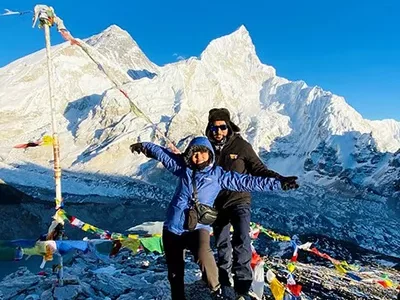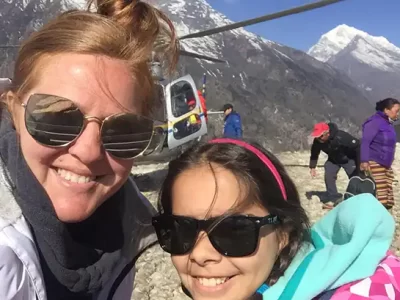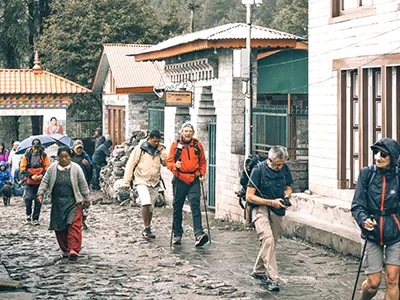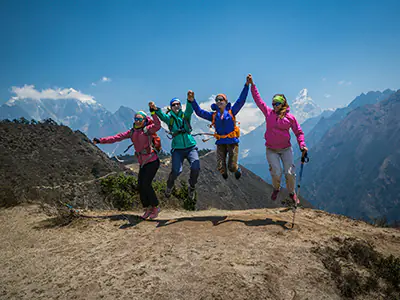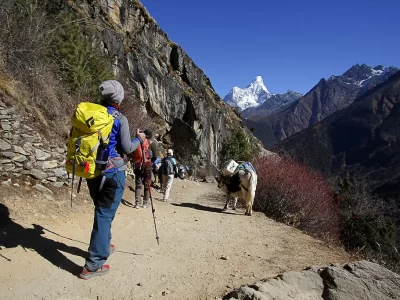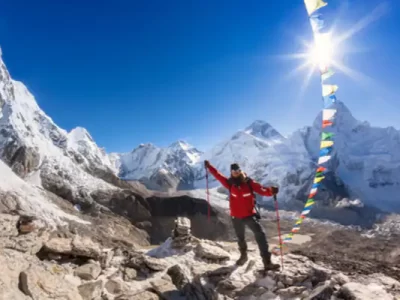Nestled in Nepal’s Khumbu Valley, the charming village of Phakding welcomes trekkers on their way to Everest Base Camp. At 2,610 meters above sea level, it offers a gentle introduction to higher altitudes. Its location, just a day’s hike from the starting point of Lukla, makes it an ideal resting place for acclimatization.
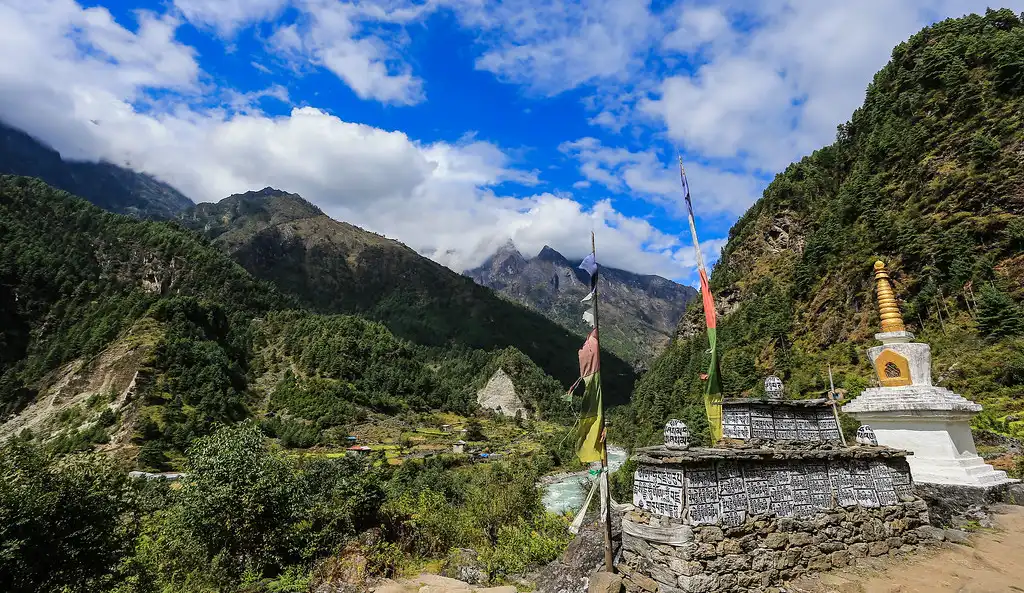
But Phakding is more than just a practical stop. The peaceful atmosphere, rich Sherpa culture, and stunning views of the Dudh Koshi River will captivate you. The village offers a variety of teahouses, lodges, and shops, ensuring trekkers have everything they need for a comfortable stay.
A Glimpse into Sherpa Heritage
The Sherpa people, renowned for their mountaineering expertise and strength in high-altitude environments, call Phakding home. The village’s architecture, religious practices, and vibrant festivals actively weave in their unique traditions.
Wander through Phakding, and you’ll find mani stones and prayer wheels inscribed with Buddhist mantras, which are said to bring good luck to those who pass. The village also boasts several monasteries and gompas, offering a window into the spiritual lives of the Sherpas. These peaceful havens often showcase elaborate murals, statues, and thangkas (Tibetan Buddhist paintings).
This place comes alive during festivals like Losar (Tibetan New Year), Dumje, and Mani Rimdu. These lively celebrations showcase traditional Sherpa dances, music, costumes, and religious rituals.
Everest Base Camp Trek
Everest Base Camp Trek with Helicopter Return
Luxury Everest Base Camp Trek
Phakding’s Geographic Location: A Vital Link in the Everest Trek
Phakding’s geographical location is crucial for trekking to the majestic Everest Base Camp. Nestled within the Dudh Koshi River valley in Nepal’s Khumbu region, Phakding sits at a Phakding elevation of 2,610 meters (8,563 feet), offering a balanced environment.
- Acclimatization: This place provides trekkers a gentler introduction to higher altitudes, reducing the risk of altitude sickness as they gradually ascend.
- Rest & Recovery: Its position, roughly a day’s trek from Lukla (where most treks begin after a flight from Kathmandu), makes it an ideal first overnight stop.
Phakding to Namche Bazaar: The Next Step
From Phakding, the trail winds towards Namche Bazaar, a bustling Sherpa town, and another essential acclimatization point.
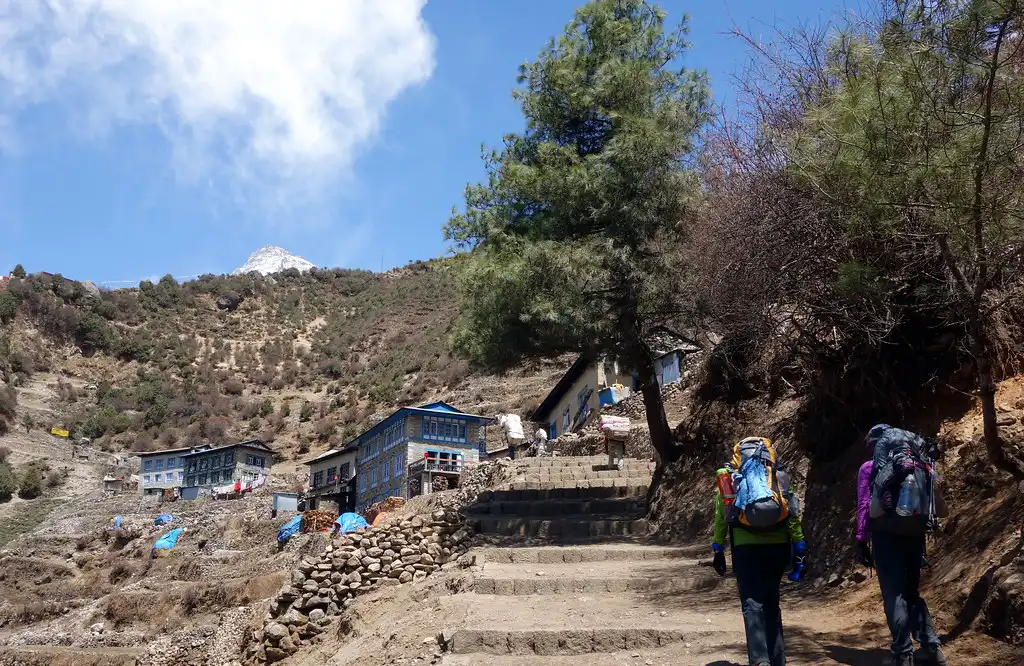
The distance from Phakding to Namche Bazaar is approximately 9 kilometers (5.6 miles), usually taking 5-7 hours.
Lukla to Phakding: The Starting Point
The trek to Phakding begins in Lukla, home to the Tenzing-Hillary Airport, the main gateway to the Everest region.
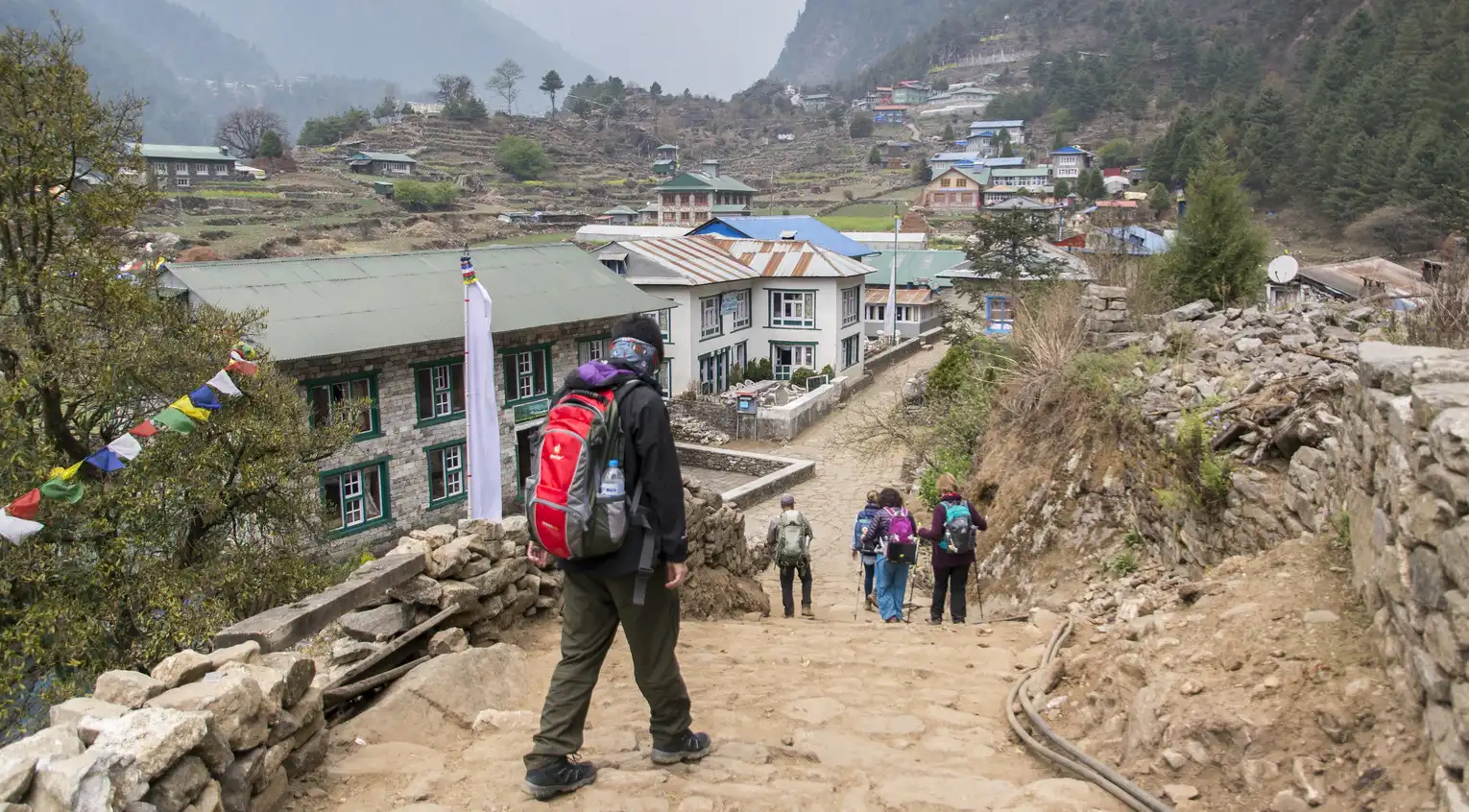
The Lukla to Phakding trekking distance is relatively short, covering about 3-4 kilometers (1.9-2.5 miles) and usually taking 3-4 hours. The trail gently slopes downward through pine forests, crossing the Dudh Koshi River on suspension bridges.
Why Phakding’s Location Matters
Phakding’s strategic position offers trekkers numerous advantages:
- Gradual Ascent: The trek from Lukla to Phakding is less strenuous than the ascent to Namche Bazaar, allowing trekkers to adjust to the change in altitude at a comfortable pace.
- Scenic Beauty: Phakding’s location offers stunning views of the surrounding mountains, lush forests, and the rushing Dudh Koshi River.
- Cultural Immersion: Trekkers can experience Sherpa culture firsthand in Phakding, from the prayer flags and mani stones adorning the trails to the warm hospitality of the local teahouses and lodges.
- Essential Amenities: This place offers many accommodations, from basic teahouses to more comfortable lodges and restaurants serving local and international cuisine.
Reaching Phakding: Your First Footsteps on the Everest Trail
Tucked away in the Dudh Koshi River valley, Phakding awaits as a critical stop on your Everest Base Camp adventure. Most trekkers begin this leg of the trek in Lukla, having flown in from Kathmandu.
The Lukla to Phakding Trek: What to Expect
- Distance: A manageable 3-4 kilometers (1.9-2.5 miles).
- Trekking Time: Plan for 3-4 hours of scenic hiking.
- Difficulty: This moderate trail features a gentle descent with a few uphill sections.
- Prime Trekking Season: Aim for spring (March-May) or autumn (September-November) for the most stable weather and clear mountain views.
Discovering the Trail from Lukla to Phakding
The trek starts at the iconic Tenzing-Hillary Airport in Lukla, named for the legendary climbers who first reached Everest’s summit. The trail quickly winds down, tracing the path of the Dudh Koshi River. You’ll cross thrilling suspension bridges, pass through charming Sherpa villages, and spot vibrant prayer flags swaying in the wind.
Sights You Won’t Want to Miss
- Dudh Koshi River: This milky-blue glacial river is your companion; its rush is a soothing soundtrack to your trek.
- Suspension Bridges: Feel the thrill as you cross high above the river. The views are truly breathtaking.
- Mani Stones: These carved stones bear Buddhist inscriptions and line the trail, adding a spiritual touch to your trek.
- Chautara: Rest stops with stone benches and colorful prayer flags, which provide a moment to catch your breath and admire the scenery.
- Hidden Monasteries: Watch for small monasteries nestled alongside the trail, a peaceful contrast to the hustle and bustle of Lukla.
- Waterfalls: Numerous cascades grace the landscape, their beauty amplified during the monsoon season.
Tips for a Successful Trek to Phakding
- Travel Light: Pack only essentials and consider hiring a porter to carry heavier gear.
- Hydration is Key: Reduce plastic waste by using a reusable water bottle and refilling it at teahouses.
- Adjust to the Altitude: Pace yourself, take necessary breaks, and stay hydrated to help your body adapt.
- Dress in Layers: Be prepared for fluctuating weather with clothing you can easily add or remove.
- Rise and Shine: Start early to avoid crowds and savor the sunrise from the trail.
- Respect Local Culture: Be mindful of Sherpa customs and traditions throughout your trek.
- Savor the Experience: The trek to Phakding is more than just a hike; it’s a chance to connect with the beauty and culture of the Everest region.
Trekking from Phakding to Namche Bazaar: Your Gateway to High-Altitude Thrills
Leaving the peaceful village of Phakding behind, you’ll ascend to the bustling Sherpa town of Namche Bazaar. The Everest Base Camp trek‘s challenging but rewarding stretch introduces you to the region’s high-altitude beauty.
Your Trek in Numbers: Phakding to Namche Bazaar
- Distance: A roughly 9-kilometer (5.6-mile) trek.
- Time: Allow 5-7 hours to complete the trek, considering your pace and acclimatization needs.
- Difficulty: Expect a moderately challenging hike with a significant elevation gain of approximately 600 meters (1,968 feet).
Trail Tales: Challenges and Rewards
Your trek begins with a gentle climb through fragrant pine forests and vibrant rhododendron groves. You’ll then trace the path of the roaring Dudh Koshi River, crossing numerous suspension bridges, including the iconic Hillary Bridge. The climb steepens as you near Namche Bazaar, with switchbacks guiding you upwards.
What to Expect
- Altitude Adjustment: The most significant hurdle is the sharp rise in elevation, increasing the risk of altitude sickness if you don’t acclimatize properly.
- Steep Terrain: Prepare for some demanding uphill sections, particularly at higher altitudes.
- Busy Trails: During peak trekking season, the path can get crowded. An early start promises a more peaceful trek away from the crowds.
What Awaits You
- Breathtaking Vistas: Enjoy panoramic views of snow-capped giants like Everest, Lhotse, and Ama Dablam.
- Sagarmatha National Park: Enter this UNESCO World Heritage Site, renowned for its diverse wildlife and dramatic landscapes.
- Namche Bazaar: Discover the vibrant heart of Sherpa culture. Explore the bustling streets, savor delicious cuisine, browse local shops, and find a cozy lodge for a well-deserved rest.
Must-See Stops
- Monjo: Monjo is a small village that is the gateway to Sagarmatha National Park. Before continuing your trek, you’ll check in with your trekking permit.
- Jorsale: The final village before Namche Bazaar, offering several teahouses and lodges for a rest stop.
- The Hillary Bridge
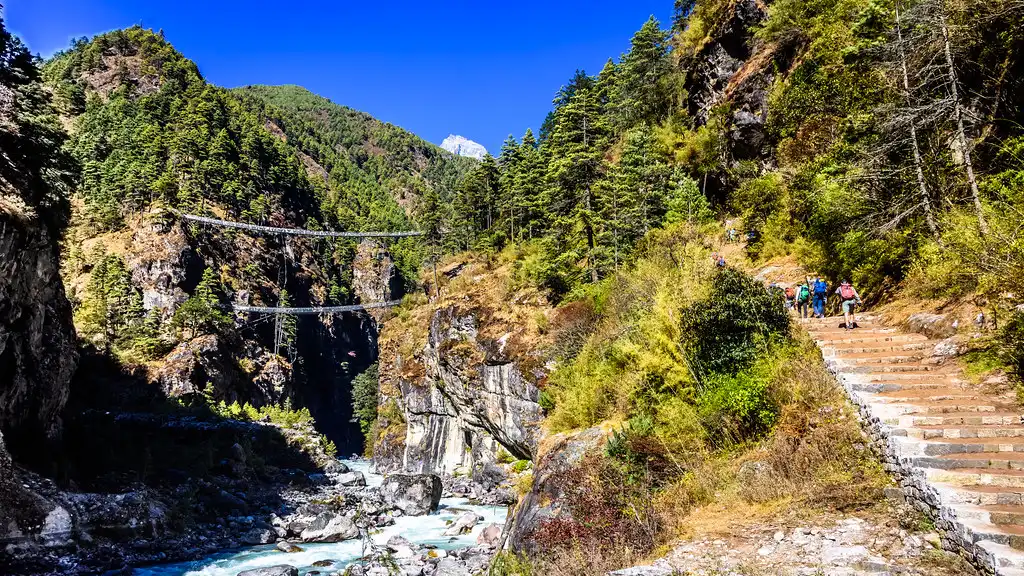
This towering suspension bridge provides adrenaline-pumping thrills and incredible Dudh Koshi River gorge views.
- Everest View Hotel: Perched above Namche Bazaar, this hotel lives up to its name with sweeping panoramas of Mount Everest and its neighboring peaks.
- Namche Bazaar: Explore the lively atmosphere, visit the Sherpa Cultural Museum, and let your body acclimatize before you continue your adventure.
Essential Tips
- Acclimatize in Phakding: Spend an extra day in Phakding to prepare your body for the higher altitudes.
- Pace Yourself: Take breaks, stay hydrated, and listen to your body’s signals.
- Get an Early Start: Beat the crowds and arrive in Namche Bazaar with daylight to spare.
- Pack for the Cold: Temperatures plummet at higher elevations, particularly at night.
- Bring a Headlamp: Be prepared for low light conditions on the trail.
Everest Base Camp Trek for Beginners
Everest Base Camp Short Trek
Jiri to Everest Base Camp Trek
Where to Stay and What to Expect
After a day of trekking from Lukla, Phakding welcomes you with open arms and various places to stay. Whether looking for a simple teahouse or a more upscale lodge, Phakding has something for every budget and taste.
Where to Rest Your Head in Phakding
This place offers trekkers a range of accommodations, mainly teahouses and guest houses. These places provide basic comforts and a chance to experience local Sherpa life.
- Teahouses: The heart of Phakding’s hospitality, teahouses provide simple rooms with shared bathrooms. They are known for their friendly atmosphere and communal dining areas, perfect for meeting fellow adventurers and swapping stories.
- Guest Houses: A touch more comfortable than teahouses, guest houses offer rooms, sometimes with private bathrooms.
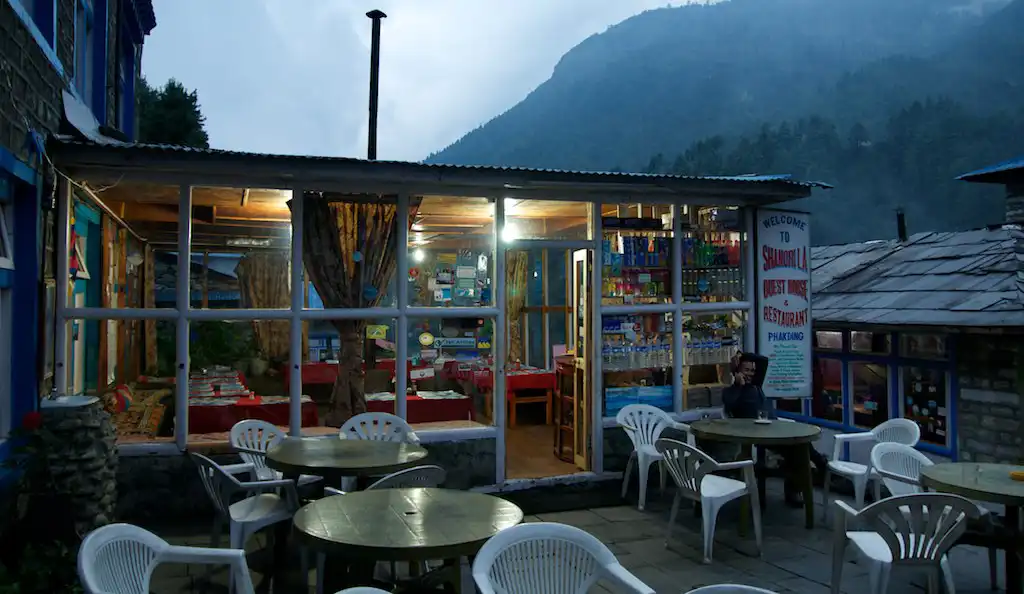
You may also find amenities like hot showers and Wi-Fi.
- Lodges: For a bit more luxury, some lodges in Phakding provide private rooms, en-suite bathrooms, and a more comprehensive range of facilities. These options are less common and typically come with a higher price tag.
What to Expect: Comforts and Amenities
- Food: Phakding’s teahouses and guest houses offer delicious meals, mainly featuring Nepalese and Tibetan specialties like dal Bhat (lentil soup with rice), momos (dumplings), thukpa (noodle soup), and fried rice. Many also serve familiar Western dishes like pizza, pasta, and pancakes.
- Water: While you can buy bottled water, bringing your reusable bottle and purifying the water is a greener (and cheaper) option. Most places will provide hot water for a small fee, which is ideal for filling your bottle and using purification tablets or a SteriPen.
- Medical Care: A small health post in Phakding handles minor issues, but carrying a basic first-aid kit and any necessary medications is essential. If you experience serious medical problems, emergency services will likely transport you to Lukla or Kathmandu for treatment.
- Other Services: Many accommodations offer charging for electronics (often for a small fee), Wi-Fi (with varying levels of connectivity), and hot showers (sometimes at an additional cost).
More Than a Stopover on Your Everest Trek
Phakding, the initial acclimatization stop on the EBC trek, is a charming Sherpa village offering more than rest. Experience the rich local culture and stunning natural surroundings for an unforgettable adventure.
Embrace the Sherpa Way of Life
- Explore the Gompas: Phakding’s multiple gompas (Buddhist monasteries) possess unique stories and atmospheres. You may even witness monks chanting or have the chance to join a meditation session.
- Chat with the Locals: Strike up conversations with the welcoming Sherpa people. Learn about their customs, traditions, and the unique challenges of living at high altitudes.
- Observe Daily Life: Wander through the village, soaking in the sights and sounds of daily activities. Browse the local shops, where you’ll find handcrafted souvenirs, essential trekking gear, and tasty snacks.
Discover Nature’s Playground
- Hike to New Heights: Short hikes near Phakding lead to awe-inspiring views of the surrounding peaks and valleys. Rise early for a breathtaking sunrise over the mountains.
- Photograph the Majestic Dudh Koshi River: This iconic glacial river is a photographer’s paradise, especially during the golden hours of dawn and dusk. Capture its turquoise waters as they flow through lush forests and past towering mountains.
- Unwind by the River: Find a quiet spot on the riverbank, where the gentle sounds of flowing water create a serene Himalayan atmosphere.
Don’t Miss These Phakding Experiences
- Savor Local Flavors: Phakding’s teahouses and restaurants tempt you with a variety of traditional Sherpa dishes, including momos (dumplings), thukpa (noodle soup), and dal bhat (lentil soup with rice). Be sure to sample the local yak cheese, a unique culinary treat.
- Acclimatize in Comfort: If Namche Bazaar is your next destination, use Phakding’s altitude for an extra day of acclimatization. Enjoy short walks, drink plenty of fluids, and rest up to prepare your body for the higher altitudes ahead.
Weather and Trail Conditions
Choosing the right time for your Phakding trek is critical to having a safe and fantastic adventure. The weather in the Everest region can be unpredictable, so let’s break down what you can expect during different times of the year.
The Sweet Spots: The Best Times to Go
Phakding and the wider Everest area offer two ideal windows for trekking:
- Spring (March-May): As winter melts away, the trails clear up, and the hillsides burst into a kaleidoscope of wildflowers. Enjoy pleasant, sunny days with temperatures around 10-20°C, but be prepared for chilly nights, particularly at higher altitudes. Spring is a popular trekking time, so you’ll likely encounter other adventurers on the trails.
- Autumn (September-November): After the monsoon season, the skies clear, revealing jaw-dropping views of the Himalayas. Temperatures are similar to spring, with pleasantly warm days and cooler nights. Thanks to the stable weather and stunning visibility, it is considered the peak season for Everest trekking.
The Rest of the Year: What You Should Know
- Summer (June-August): The monsoon season brings heavy rains, turning trails into muddy, slippery paths. You might also encounter leeches. While the landscape is lush and green, the rain often obscures those magnificent mountain views.
- Winter (December-February): Temperatures plunge, and higher elevations see frequent snowfall. Be aware that snow and ice conditions can render trails inaccessible. Though the winter scenery is undeniably beautiful, trekking conditions become significantly more challenging.
Choosing Your Ideal Time to Trek
Be sure to consider these factors when deciding when to visit Phakding:
- Crowds: If you prefer solitude, consider the shoulder seasons (April-May or September-October) when trails are less busy.
- Weather: Spring and autumn offer the most predictable weather for trekking.
- Temperatures: Spring and autumn are generally milder than winter but pack for chilly nights, especially at higher altitudes.
- Mountain Views
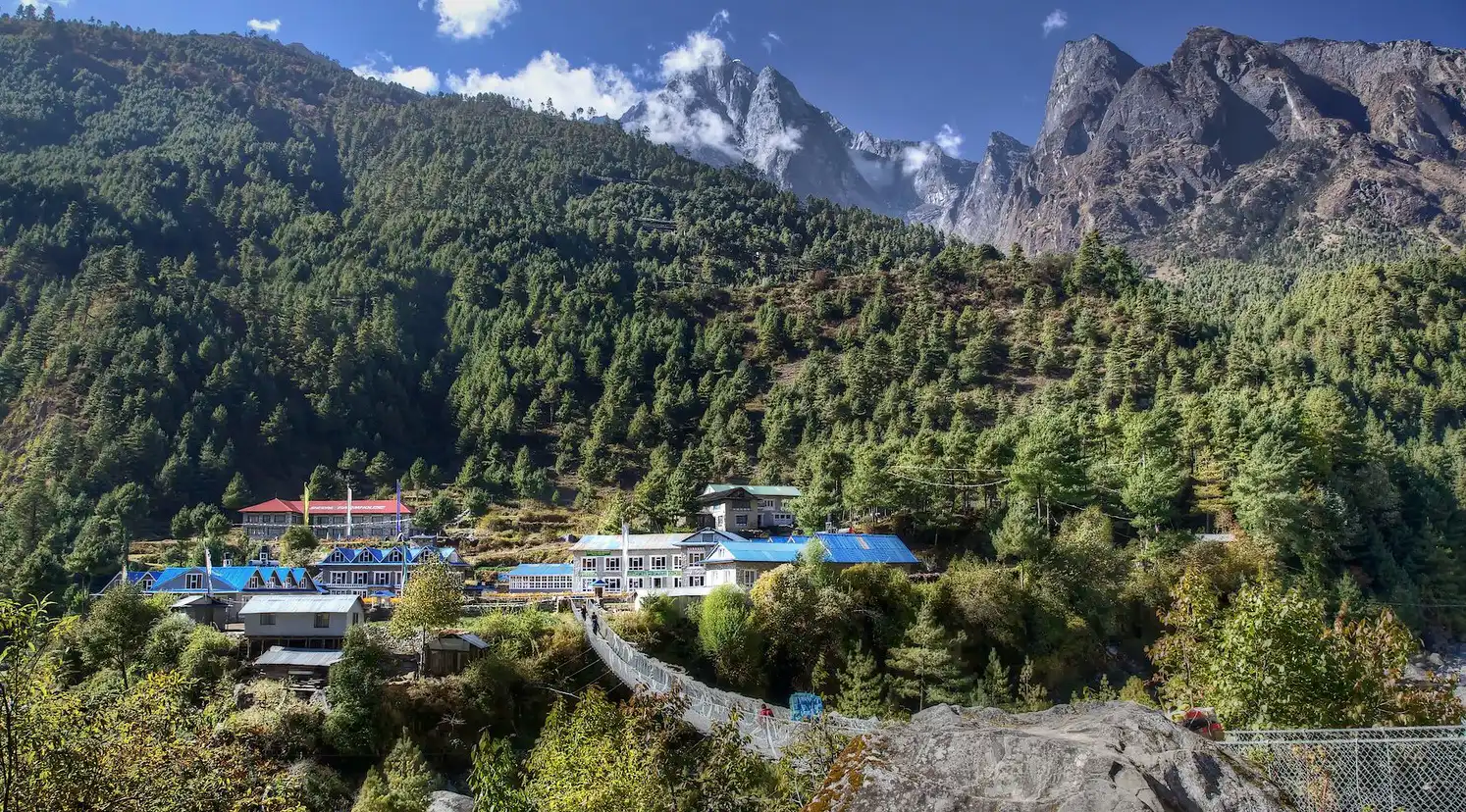
Autumn often boasts the clearest skies and most spectacular Himalayan vistas.
- Your Preferences: The best time to go is subjective, influenced by your preferred weather, crowd size, and scenic vistas.
Packing for Every Season
No matter when you go, pack these essentials for your Phakding trek:
- Waterproof & Windproof Jacket: Shield yourself from rain, snow, and chilly gusts.
- Warm Layers: Pack a fleece jacket, thermal layers, a hat, and gloves to stay cozy.
- Sturdy Hiking Boots: Choose boots with excellent ankle support and grip for those rugged trails.
- Sun Protection: Don’t forget a hat, sunglasses, and sunscreen, even at higher altitudes.
- Rain Gear: Pack a rain jacket and pants for monsoon trekking.
Gearing Up and Staying Safe on Your Phakding Trek: Essential Advice
You are heading to Phakding, whether as a stepping stone to Namche Bazaar or as a destination itself, and this requires some intelligent preparation. Here’s the lowdown on the gear you’ll need, how to stay healthy at altitude, and other vital tips to ensure your trek is successful.
Pack Smart: Your Essential Gear List
The right gear can make a world of difference on your Phakding adventure. Here’s what to pack:
- Backpack: Choose a sturdy, comfortable backpack with plenty of room for essentials (30-40 liters is a good size).
- Hiking Boots: Invest in broken-in hiking boots with ankle support and good grip.
- Clothing: Layer up! Pack moisture-wicking base layers, warm fleece or down mid-layers, and a waterproof outer layer. Pack warm socks, gloves, a hat, and a neck gaiter.
- Sleeping Bag: Nights can get chilly, so bring a sleeping bag rated for below-freezing temperatures.
- First Aid Kit: Pack a well-stocked kit with bandages, antiseptic, pain relievers, blister care supplies, and any personal medications you need.
- Water Bottle or Hydration System: Proper hydration is essential for trekking at altitude. Pack a reusable water container to ensure you have enough water.
- Snacks: Pack energy-boosting snacks like trail mix, nuts, or dried fruit.
- Headlamp or Flashlight: Don’t get caught in the dark! Light sources are essential for early starts, late arrivals, or unexpected situations.
Health and Safety at Altitude
Trekking at high altitudes, such as the Phakding altitude of 2,610 meters (8,563 feet), requires awareness of altitude sickness. Here’s how to stay safe:
- Take it Slow: Ascend gradually to give your body time to adjust to the thinner air.
- Drink Up: Stay well-hydrated and avoid alcohol.
- Listen to Your Body: If you experience headaches, nausea, dizziness, or shortness of breath, immediately descend to a lower altitude.
- Consider Diamox: This medication can help prevent and treat altitude sickness, but talk to your doctor first.
More Tips to Stay Safe
- Hire a Guide: Benefit from a guide’s expertise in navigation, healthcare, and local knowledge.
- Trek with a Buddy: Sharing the adventure with a friend is safer and more fun.
- Check the Forecast: Mountain weather can change quickly, so be prepared for anything.
- Stick to the Trail: You can help protect the fragile environment by staying on marked paths and minimizing your impact on wildlife.
- Share Your Plans: Tell someone back home about your itinerary and when you expect to return.
Himalayan Gem You Won’t Want to Miss
This place is much more than a pit stop on your way to Everest Base Camp. This charming village blends natural beauty, vibrant Sherpa culture, and a strategic location to create an extraordinary experience. Whether adjusting to the altitude, soaking in the scenery, or immersing yourself in local life, this place has something for everyone.
Why Phakding Deserves a Spot on Your Itinerary
- Your First Taste of the Himalayas: After your flight to Lukla, Phakding is your first stop. The high-altitude environment here will welcome you before continuing to Namche Bazaar.
- A Photographer’s Paradise: Nestled in the Dudh Koshi River valley and surrounded by majestic peaks, this place offers breathtaking views at every turn.
- Cultural Immersion: This place is a window into Sherpa culture. You can engage with locals, explore ancient monasteries, and experience a traditional festival.
- Comfort and Convenience: Whether you’re gearing up for your next trek or relaxing after hiking, this place provides comfortable accommodations, delicious food, and essential amenities.
Your Phakding Story: An Adventure to Remember
The memories you make in Phakding will last a lifetime. The warmth of the locals, the stunning mountain vistas, and the unique cultural experiences will stay with you long after you’ve left.
Explore Phakding while trekking to Everest Base Camp. Wander off the beaten path, indulge in the local cuisine, and embrace this charming village’s adventure spirit. You won’t regret it!

